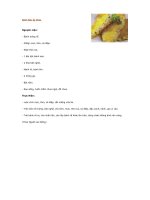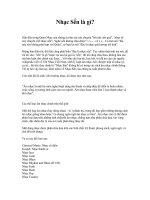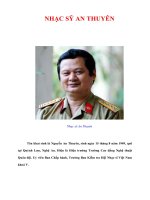Tài liệu Baseball Superstars Hank Aaron docx
Bạn đang xem bản rút gọn của tài liệu. Xem và tải ngay bản đầy đủ của tài liệu tại đây (1.39 MB, 129 trang )
BaseBall
superstars
Hank Aaron
Hank Aaron
Ty Cobb
Lou Gehrig
Derek Jeter
Randy Johnson
Mike Piazza
Kirby Puckett
Jackie Robinson
Ichiro Suzuki
Bernie Williams
Hank
Aaron
Hank
Aaron
J. Poolos
BaseBall
superstars
For Helena, who swings for the fence
HANK AARON
Copyright © 2007 by Infobase Publishing
All rights reserved. No part of this book may be reproduced or utilized in any form or
by any means, electronic or mechanical, including photocopying, recording, or by any
information storage or retrieval systems, without permission in writing from the publisher.
For information, contact:
Chelsea House
An imprint of Infobase Publishing
132 West 31st Street
New York NY 10001
Library of Congress Cataloging-in-Publication Data
Poolos, James.
Hank Aaron / J. Poolos.
p. cm. — (Baseball superstars)
Includes bibliographical references and index.
ISBN-13: 978-0-7910-9536-2 (hardcover)
ISBN-10: 0-7910-9536-3 (hardcover)
1. Aaron, Hank, 1934- 2. Baseball players—United States—Biography.
3. African American baseball players—Biography. I. Title. II. Series.
GV865.A25P66 2007
796.357092—dc22
[B] 2007005916
Chelsea House books are available at special discounts when purchased in bulk quantities
for businesses, associations, institutions, or sales promotions. Please call our Special Sales
Department in New York at (212) 967-8800 or (800) 322-8755.
You can find Chelsea House on the World Wide Web at
Series design by Erik Lindstrom
Cover design by Ben Peterson
Printed in the United States of America
Bang EJB 10 9 8 7 6 5 4 3 2 1
This book is printed on acid-free paper.
All links and Web addresses were checked and verified to be correct at the time
of publication. Because of the dynamic nature of the Web, some addresses and links
may have changed since publication and may no longer be valid.
CONTENTS
The Birth of a Legend
1
A Foot in the Door
11
The Minor Leagues
18
Class A
25
Breakthrough to the Big Leagues
34
Rising Star
42
The Greatness of Hank Aaron
53
Home in Atlanta
65
Home-Run Champion
76
A Life After Baseball
93
Statistics 103
C
hronology 105
Timeline 106
Glossary 109
Bibliography 112
F
urther Reading 114
Index 1
17
1
2
3
4
5
6
7
8
9
10
1
There is no greater feeling in sports than the one a player gets
when his teammates are genuinely excited over one of his own
personal accomplishments—excited just to be his teammate.
What I remember is that everybody was right there celebrating
with me, as if my record was their record, too. A player can’t
ask for any more than that.
—Hank Aaron, I Had a Hammer: The Hank Aaron Story
A
t first glance, Hank Aaron’s story is that of a baseball
player who broke one of the most coveted records in the
sport: Babe Ruth’s long-held mark of 714 career home runs.
But it is really the story of an important period in the history
of the United States, a period that marked the emergence of
racial equality in “America’s pastime” and, if not the end of
bigotry in baseball, certainly the most significant step forward
The Birth
of a Legend
2
HANK AARON
for black athletes in any sport. For it was during the course of
Aaron’s career that Major League Baseball teams were at last
allowed to add black players to their rosters, changing the face
of the game, and of American culture in general, forever.
It was between the white lines of the baseball diamond in
the 1950s that African Americans, as players, were permitted
to mingle with whites on a more-or-less equal basis. Blacks
played on the same ball fields with whites. They traveled to and
from games on the same buses, and they suited up in the same
locker rooms. At the time, similar occurrences were unheard of
in mainstream culture.
Although the laws of segregation were less in force in the
Northern states, interaction between the races remained nearly
as limited there as in the South. Black people were regarded as
second-class citizens in much of the United States. In the South,
African Americans were segregated, or separated, from whites,
in basic and profound ways. For example, as a rule, if a black
man wanted to eat lunch at a restaurant that allowed African
Americans (and many of them did not), he entered through the
back door. Black people drank from separate drinking foun-
tains than white people. Buses had “white-only” seating toward
the front and middle, while blacks sat in a designated section
in the back.
As a general rule, individuals of each race came together
only when one worked for the other. In the South, black nan-
nies, maids, laborers, and farmers may have built relationships
with their white bosses; otherwise, a black person did not go
out of his or her way to speak to a white person unless they
were spoken to first.
This is not to say that healthy relationships between black
and white individuals did not occur. Such relationships were
common. But even among the vast majority of racially toler-
ant Americans—blacks and whites—there was an acceptance
of order: whites were citizens, and blacks served them. The
opportunity for blacks to enjoy successful lives was limited.
3
The Birth of a Legend
Hank Aaron looks up toward the camera in this portrait taken in 1957 in
Milwaukee. That year, Aaron won the National League’s Most Valuable
Player award. During the 1950s, African Americans were treated as
second-class citizens across much of the United States, suffering
segregation in many public places. On the baseball diamond, though,
racial equality was beginning to emerge.
4
HANK AARON
They lived in the poor neighborhoods, had the dirty jobs, and
wore the secondhand clothes. Because black children attended
second-rate public schools, the future was no brighter than the
present. With such obstacles, it was thought that black men
were not destined for greatness.
Hank Aaron rose above racism and bigotry to become a
hero. He defined greatness in his generation with his bat and
with his inner strength. He rose from an anonymous Negro
League ballplayer to a star in the major leagues, though one
who was still a target of racism. Through this transformation,
Aaron persevered to become a national symbol of triumph in
the face of true adversity.
During the Great Depression, which began in 1929 and
lasted through much of the 1930s, a black man living in the
Deep South did all he could just to survive. Times were hard,
particularly for the people of Mobile, Alabama, where the
once-thriving cotton industry that had been the staple of the
state’s economy was in rapid decline. Jobs for laborers were in
short supply.
Back then, 30 years before the famous March on
Washington, the day Martin Luther King, Jr., delivered his
monumental “I Have a Dream” speech, African Americans were
denied the basic opportunities typically enjoyed by whites, like
the right to vote. Thirty years before the passage of the Civil
Rights Act of 1964, which prohibited discrimination in public
places, in government, and in employment, there were no black
players in Major League Baseball. Thirty years before these
events, a man who rewrote history was born.
ROOTS IN MOBILE
Hank’s father, Herbert Aaron, moved his young wife, Estella,
to Mobile, Alabama, in the late 1920s, just before the Great
Depression. At the time, Mobile was a small, quiet city of about
80,000 people. Unlike many Southern cities, which clung to
old-fashioned values, Mobile was relatively progressive and
5
The Birth of a Legend
forward thinking. In part, these qualities were due to the city’s
very identity: Mobile was a seaport town, and as a hub for
transportation and shipping, it was a rather worldly place, at
least in comparison with some of the South’s more isolated
rural areas.
In terms of racism, according to Hank Aaron’s autobiogra-
phy, I Had a Hammer, progressive politicians in Mobile spoke
of equal rights between blacks and whites long before civil
rights became a popular cause. A local chapter of the NAACP
was started in the 1930s. Public libraries in Mobile opened their
doors to black people while, across most of the South, African
Americans were not even encouraged to learn to read. Make no
mistake, however: Racism and all that came with it were noth-
ing short of normal in Mobile.
Herbert and Estella Aaron came to Mobile in the wave of
rural African Americans who moved there to look for work.
Herbert Aaron moved his family into a mostly black neighbor-
hood called Down the Bay and began to scrape out a living in
the shipyards. Times were tough for everyone. The Depression
brought waves of layoffs, and Herbert struggled to find steady
work. For a while, Estella worked as a housekeeper and cleaning
woman. In fact, most of the African Americans who migrated
to Mobile during the Depression found work not in Alabama’s
cotton industry but as maids, nannies, and cooks in the homes
of white people. It was not long, though, before Estella turned
her attention away from domestic work and toward the family
she would raise.
Henry Louis Aaron, Herbert and Estella Aaron’s third child,
was born on February 5, 1934. “Hank,” as he would later be
called, came into the world one day before baseball great Babe
Ruth’s thirty-ninth birthday. At the time, the Aarons lived in
an apartment on Wilkinson Street in Down the Bay and would
spend the next several years there. As World War II began, more
and more people came to Mobile to work in the shipyard. By
now the Aarons had six children, and they were outgrowing
6
HANK AARON
their apartment. In 1942, Herbert and Estella decided it was
time to find their family a home with more room.
Herbert Aaron paid $110 for two vacant lots on Edwards
Street in the nearby village of Toulminville, where many of
Mobile’s black families were moving to escape the overcrowded
city. There, Herbert planned to build his family a home. The
building next to the Wilkinson Street apartment had recently
been torn down, and Herbert acquired the lumber and hired a
pair of carpenters to build a house.
The new house had six rooms, which was several more than
the Aaron family had ever had. The house had no lights and no
windows to let in light, but the Aarons had no rent or mortgage
to pay either, so no one complained.
“We were a proud family because the way we saw it, the
only people who owned their own homes were rich folks and
Aarons,” Hank Aaron recounted in I Had a Hammer. The new
home, though, presented plenty of challenges. Herbert contin-
ued to gather building materials wherever he found them and
over time put the finishing touches on the home.
Toulminville provided a quiet, rural setting for the
Aarons. The village was known for its groves of oak trees and
for the county fair organized by the village’s founder, General
Theophilus Toulmin. The folks there had cows, chickens,
and hogs. And watermelon and blackberry patches were
sprinkled among the fields of corn and sugarcane. Cars drove
on mud roads, often getting stuck during the rainy months.
The setting was a perfect one for a boy who dreamed only of
playing baseball.
Hank and his siblings had many chores. They gathered
wood to be used to heat the house and cook their food. With
so many people to feed, Estella learned how to stretch her sup-
plies. Most of what the Aarons ate came from their garden. The
family ate staples like cornbread, greens, and beans. Now and
then, they had some pork, beef, or chicken. The kids shared
beds and clothing. In fact, Hank thought nothing of wearing
his sister’s hand-me-downs.
7
The Birth of a Legend
Estella worked hard to provide a good home for her hus-
band and her children. Occasionally she took a job cleaning
houses, but she spent most of her time keeping the children in
line. Herbert worked in the shipyard when he could find work,
usually as a boilermaker’s assistant. To earn money when he
was out of a job, he opened a small tavern next to the family’s
house. It was called the Black Cat Inn, and it was the only tav-
ern in Toulminville in which black people were allowed to go.
People came to drink moonshine, an illegally made alcoholic
drink, and dance. Hank’s oldest sister, Sarah, ran the tavern.
After the neighbors complained about the noise, though, the
Jackie Robinson fields a ball at first base in April 1947 at Ebbets Field
in Brooklyn. Robinson made his debut that season with the Brooklyn
Dodgers, becoming the first black player in the major leagues. The fol-
lowing year, Robinson visited Hank Aaron’s hometown in Alabama, giv-
ing Hank the chance to see his hero and forge his big-league dreams.
8
HANK AARON
Aarons were forced to close the inn. Young Hank mowed lawns
and did odd jobs, like picking potatoes or mixing cement, but
his heart was not in that kind of work. Even at an early age,
baseball was all that was on his mind.
BASEBALL DREAMS
Hank and some of the youngsters in the neighborhood would
often get pickup games going in the fields near the pecan
groves that bordered his house. When no one was around to
play, he practiced hitting a ball with a stick. He learned how
to throw a ball onto the roof of his house and hit it when it
Jackie Robinson was the first black baseball player in the modern
era of the major leagues. Born in 1919, Robinson was raised in
Pasadena, California. As a youngster, he was an outstanding ath-
lete in several sports. He attended Pasadena Junior College and
then the University of California, Los Angeles, where he starred
in baseball, football, and track. Robinson led a full life before he
played his first game of professional baseball. He enlisted in the
U.S. Army in 1942 and attended officer-candidate school. A year
later, he was a second lieutenant. After his discharge in 1944,
Robinson played professional football for a short time before join-
ing the Kansas City Monarchs of the Negro National League
in 1945.
Robinson’s stay with the Monarchs was short-lived. Later
that year, Branch Rickey, who was president of the Brooklyn
Dodgers in the major leagues, signed Robinson to the Dodgers
organization. Rickey had been trying to persuade baseball team
owners to open their minds to integrated baseball. He thought
that Robinson represented great talent, but just as important, he
JACKIE ROBINSON
9
The Birth of a Legend
rolled down. Most of the time, he did not have a real baseball.
So he made his own by wrapping a piece of hose around a golf
ball or by wadding tape into a ball. He even used tin cans and
bottle caps. Hank would spend hours in his front yard hitting
bottle caps with a piece of broomstick.
Toulminville had plenty of wide-open space, and the
neighborhood kids made a baseball diamond in one vacant
lot. There, they played until dark. Soon, the village became
part of Mobile, and the city built the black residents a rec-
reational park that included real baseball diamonds. Hank
spent his days after school on those diamonds, playing on
saw that Robinson was a man of dignity who would be strong
in the face of adversity. Robinson started out with the Montreal
Royals, a Dodger minor-league team. He led the league in bat-
ting average during his first and only season with the Royals. In
1947, Robinson joined the Dodgers. It was a landmark event that
changed baseball forever.
Robinson did not take long to make his mark as a player.
He was voted Rookie of the Year and led the league in stolen
bases. In 1949, he won the batting title with a .342 average.
That year, he was also voted the National League Most Valuable
Player. Robinson’s success continued until his retirement in
1957. He was inducted into the Baseball Hall of Fame. His
autobiography, I Never Had It Made, was published in 1972,
the year he died. Every major-league team has retired
No. 42 to honor Robinson. In 1987, to mark the fortieth anni-
versary of Robinson’s breaking the color barrier, Major League
Baseball renamed the Rookie of the Year award the Jackie
Robinson Award.
10
HANK AARON
local teams, usually against teams from Mobile and the sur-
rounding area.
Hank’s uncle taught him about baseball, taking the young-
ster under his wing for a game of catch or some batting prac-
tice. Hank, though, was also inspired by more accomplished
players, like the legendary Jackie Robinson. In 1947, Robinson
became the first black player in the major leagues. He was a
hero to Hank and to the other men, women, and children of
Toulminville, just as he was to people in other black communi-
ties across the country.
One day in 1948, Robinson visited Toulminville, and Hank
skipped class to hear him speak. The great player talked at
length about baseball and community. Afterward, Hank was
inspired to dream bigger dreams, and he thought that one day
he, too, might play professional baseball like his hero.
Hank’s parents would come to support his dreams, but
their backing would not come easily. Herbert and Estella placed
a high value on education and insisted that their children’s
schoolwork come before everything else. Although Hank’s
father understood his son’s need to play baseball, his mother
was more reluctant. Her dream was that Hank would attend
college and make a better life for himself and for the black
community. She even encouraged him to go out for football
instead of baseball, because a good athlete like him might earn
a football scholarship to college.
Hank, though, wanted nothing to do with football.
Baseball was his sport, and he stuck to his guns. He was no
prize student, but he at least made a minimal effort at school,
if only to appease his mother. Aside from being in the Boy
Scouts, Hank spent his early teenage years reading comic
books, shooting marbles with friends, and playing ball. It was
during this time, in the open fields of Toulminville, that Hank
Aaron began to live his dream.
11
A
lthough Hank Aaron played plenty of baseball in pickup
games, neither he nor any other black kids were allowed
to play in organized leagues. If African Americans wanted to
play organized ball, they played softball in a recreation league.
One day when Hank was playing softball, a local man named
Ed Scott came to watch, as he sometimes did, with the hope
of finding a young prospect for his team. Scott was a player/
manager with the Mobile Black Bears, a local semiprofessional
baseball team made up of black players, mostly adults.
Right away, Scott saw that Hank had a talent for baseball
and wanted him to play for the Black Bears. Hank’s mother
thought that her son, who was 17, was too young to play on
a team of grown men. Furthermore, she wanted him to fin-
ish high school and go to college. After a lot of begging from
A Foot
in the Door
2
12
HANK AARON
Hank and Scott, she allowed him to play at the team’s home
games but not to travel for its away games. So Hank played
the Sunday home games in the nearby town of Prichard. As
one of the better fielders on the team, he played shortstop.
Hank was paid $10 per game, which was a lot of money
for him.
Besides managing the Black Bears, Scott was a part-time
scout for a more prominent team, the Indianapolis Clowns,
which were part of the Negro American League. Scott had
been sending reports on the talented young player to the
Clowns’ management, who grew eager to see Hank in action.
Scott arranged for the Clowns to come to Prichard to play
the Black Bears so that the Clowns’ business manager, Bunny
Downs, could get a look at him. Hank hit well that day,
and Downs offered him a spot on the team. Hank’s mother,
though, would have nothing to do with the offer, insisting
that Hank return to school in the fall to finish his final year.
Downs agreed to send for Hank in the spring when school
was out, but Hank figured that Downs would forget all
about him.
Hank had bigger dreams. He wanted to play in the major
leagues. That summer, the Brooklyn Dodgers held a tryout for
black players in Mobile. Hank’s idol, Jackie Robinson, played
for the Dodgers, as did Roy Campanella, another black player.
Hank had a feeling that he would one day play alongside
Robinson, so he went to the tryouts with the idea that this was
his big chance.
Hank, though, faced stiff competition. Plenty of very
good players came to the tryouts, and many were cockier and
physically bigger than Hank. It was hard for him to get noticed.
When it was his turn to bat, he took only a few swings before a
bigger guy pushed him out of the batter’s box. Some scouts told
him he was too small and would never make the major leagues.
Hank was disappointed and no longer as much of a Dodgers
fan as he had been. The lesson, though, was a good one for a
13
A Foot in the Door
player who would later face plenty of stinging criticism from
racist fans.
Hank went back to school, wondering if the Clowns would
come through for him in the spring. That winter, in early 1952,
he received a contract in the mail offering him $200 a month to
play ball for the Clowns. He was to report to spring training in
Winston-Salem, North Carolina. Hank’s mother wanted him to
finish the year at school, but Hank remembers, “Two hundred
dollars was a lot of money to a family like ours.” Hank also
promised that, if he made the team, he would finish school in
the off-season and, if he did not make the team, he would go on
to college. His mother allowed him to go, and a few days later,
he was on the bus to Winston-Salem.
HANK GETS A BREAK
When Hank arrived in Winston-Salem, he expected to learn
about the game and have the chance to showcase his hitting.
He found, though, that the other players were not all that
interested in him. The Clowns had won the Negro American
League championship the previous season, and for the most
part, the players thought the team would do just fine with or
without his talent. Hank took the veterans’ barbs in stride.
They poked fun at his ragged clothes, shoes, and glove. They
also did not let him bat very often. He mostly watched from
the sidelines while the other players practiced.
Hank was learning that ball clubs traditionally give rookies
a hard time. It did not help that he was shy and quiet. Most of
the players were in their mid-30s and had seen a lot more of
the world than Hank had. Unlike his future, their futures were
no longer promising. In those days, players stayed in the Negro
Leagues and made a couple of hundred dollars a month. Times,
though, were changing. These veterans knew that some of the
younger players might have a shot at the big leagues, which
meant the opportunity for higher salaries and more fame, and
they must have held some resentment against a kid like Hank.
14
HANK AARON
At the time, Hank did not have much hope either. He was
getting little practice time. As spring training gave way to exhi-
bition games, though, Hank caught a break. One of the start-
ing infielders became injured, and Hank was put in the lineup.
Immediately he began to produce hits. Soon, he settled in and
became a consistent player. And around the league, players
and managers began to pay attention to him. Syd Pollack, who
owned the Clowns, noticed him, too. He wrote a letter to the
farm director of the Boston Braves, a major-league team, and
mentioned Hank’s talents.
At 18 years of age, Hank found himself batting cleanup,
the fourth position in the lineup, for the defending Negro
American League champions, with his picture on promo-
tional posters that appeared in every town in which the team
played. The Clowns traveled through Texas and Oklahoma,
then headed through the South and up the East Coast. It was
a grueling, often boring, life. The team members got off the
bus to play games and then got back on again to head to the
The Indianapolis Clowns, pictured in this 1948 photograph, began as a
barnstorming team that was known for its slapstick routines. The play-
ers were also respected for their baseball skills. In 1952, 18-year-old
Hank Aaron received a contract for $200 a month to play for the Clowns,
who had won the Negro American League title the year before.
15
A Foot in the Door
next town. They rarely stopped for meals because few restau-
rants would serve black people. In fact, Hank recalls sitting
in a restaurant in Washington after a meal with the team and
listening to the cooks in the kitchen break the plates. Their
Before the Indianapolis Clowns joined the Negro American
League, they were a traveling team that emphasized entertainment
over competition. They began in 1929 as the Miami Giants and
became the Ethiopian Clowns before they settled on Indianapolis
as a “home.” The Clowns played a brand of baseball that was a
combination of slapstick gags and witty miscues. It was a model
of entertainment popularized by basketball’s Harlem Globetrotters.
Some of the stars were Buster Haywood and Goose Tatum (who
also played for the Globetrotters).
The Clowns were respected as ballplayers. The crowds,
though, came for the comedy. The players pulled stunts like
batting in a rocking chair, and the pitchers would often throw
the ball behind their backs or through their legs. During the
brief warm-ups before the beginning of each inning, they did
a “shadowball” routine, in which the players went through the
motions of fielding and throwing without the ball.
The Clowns used their comedy to draw white audiences to
their games and wowed them with their baseball skills, helping to
pave the way for the acceptance of black baseball players.
When the Clowns joined the Negro American League in 1943,
the team toned down its antics a bit. After the demise of the
Negro Leagues, the Clowns continued as a barnstorming team and
returned to their comedy routines. The team remained in opera-
tion until the 1980s.
The BarnsTorming Clowns
16
HANK AARON
reasoning: No white person would want to eat off those
plates even if they had been washed.
The buzz surrounding Hank and his talents had grown into
a steady drone, and quite a few major-league teams were inter-
ested in the young star. According to Aaron’s autobiography,
the Chicago Defender reported that “major-league scouts are
swarming to parks where the Clowns are playing to get a good
look at the young Aaron. . . . All seem to agree that he stands at
the plate like a Ted Williams.”
One day, after Hank had several hits during a game in
Buffalo, a man called him over. Dewey Griggs, a scout for
the Boston Braves, noticed that Hank grabbed the bat cross-
handed, or with the “wrong” hand on top. He introduced him-
self and told Hank to try to hit with his hands in the correct
position—as a right-handed batter, with his right hand on top.
Hank gave it a try and hit a home run the first time.
Griggs was impressed and sent a letter to John Mullen, the
Braves’ farm director, praising Hank’s hitting but expressing
some concern about his fielding and throwing. Hank tended to
throw sidearm to first base and flip the ball underhand to sec-
ond base. Griggs was looking for a player with a good throwing
arm and wanted to see Hank play again. After watching Hank
play another game, Griggs was convinced that he had the abil-
ity to play in the big leagues. More than a few teams, however,
were interested in Hank. In fact, Hank was considered the best
prospect in the Negro Leagues since Willie Mays, who at the
time was tearing up the majors with his crisp hitting and flashy
fielding. Mays’s team, the New York Giants, wanted Hank to
play alongside Mays.
In late May 1952, as Clowns owner Syd Pollock enter-
tained offers from teams for Hank’s services, Hank thought
about the pros and cons of playing for each team. On one
hand, it would be great to play alongside Mays in New York.
On the other, the Braves were willing to pay him a bit more
money, and he felt he had a better chance of making that team
17
A Foot in the Door
over the talent-heavy Giants. In the end, the Braves made a
better offer, and Hank signed a contract. He would make $350
each month and report to the club’s Northern League team
in Eau Claire, Wisconsin. This step was an important one for
Hank. He had crossed over from the Negro Leagues to the
majors and mainstream white culture.
18
H
ank Aaron was not the only one to profit from being
picked up by the Boston Braves. Syd Pollock, who owned
the rights to Aaron as a player, made several thousand dol-
lars in the deal. He presented the young star with a cardboard
suitcase as a signing bonus. On June 8, Aaron played for the
Clowns in Chicago, then boarded a small, twin-propeller air-
plane for the short jaunt to Eau Claire—the first time he had
ever flown on a plane.
When Aaron arrived, the team was on the road, so he
checked into the local YMCA. The two other African-American
players on the team—Julie Bowers and a young player named
John “Wes” Covington—were rooming at the Y. Like Aaron,
Covington had a promising career ahead of him.
3
The Minor
Leagues









